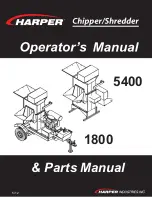
27
Solution:
a. From Fig. 27 find that deflection force for type A, super
belt with 5-in. small sheave PD is 4 to 5
1
/
2
lb.
b. Deflection =
16
/
64
=
1
/
4
in.
c. Increase or decrease belt tension until force required for
1
/
4
-in. deflection is 5 lb.
Check belt tension at least twice during first operating
day. Readjust as required to maintain belt tension within
the recommended range.
With correct belt tension, belts may slip and squeal momentarily
on start-up. This slippage is normal and disappears after unit
reaches operating speed. Excessive belt tension shortens belt life
and may cause bearing and shaft damage.
After run-in, set belt tension at lowest tension at which belts will
not slip during operation.
START-UP
General
Complete the start-up checklist on page CL-1 before attempting
system start-up.
1. Set indoor thermostat system switch to OFF position and fan
switch to AUTO position.
2. Check all electrical connections, fuses, starter and pressure
control resets.
3. Turn on condenser water supply.
4. Set selector switch on thermostat to the ON position. Adjust
evaporator fan speed if needed. If an airflow is not specified,
use the nominal airflow from Tables 4-9 and adjust the fan
speed to compensate for actual job conditions. Use Table 1 to
determine proper fan speed.
5. Set thermostat at a setting below room temperature. Com-
pressor will start. If compressor suction pressure does not
drop and discharge pressure does not rise to normal levels at
start-up, reverse any 2 compressor power leads and restore
power to ensure compressor was not wired to run in reverse
direction.
6. Set thermostat as desired.
Compressor Rotation
To determine whether or not compressor is rotating in the proper
direction:
1. Connect service gages to suction and discharge pressure
fittings.
2. Energize the compressor.
3. The suction pressure should drop and the discharge pressure
should rise, as is normal on any start-up.
4. If the suction pressure does not drop and the discharge pres-
sure does not rise to normal levels, the compressor may be
rotating in the wrong direction.
5. Since the compressor and fan motors are connected in phase
during production, it is likely that the evaporator and con-
denser fans are probably also rotating in the wrong direction.
6. Turn off power to the unit, lock and tag disconnect per stan-
dard safety procedures.
7. Reverse any two of the unit power leads.
8. Remove lock and tag per standard safety procedures and
apply power to the unit.
9. The suction and discharge pressure levels should now move
to their normal start-up levels.
NOTE: When the compressor is rotating in the wrong direc-
tion, the unit makes an elevated level of noise and does not
provide cooling.
CAUTION
To prevent injury, ensure that ducting or wire fan guards are
installed on the condenser fan before starting the unit.
















































